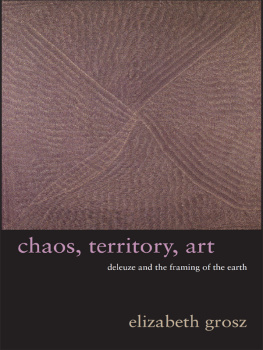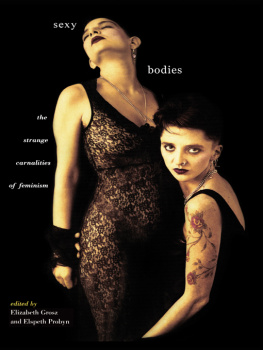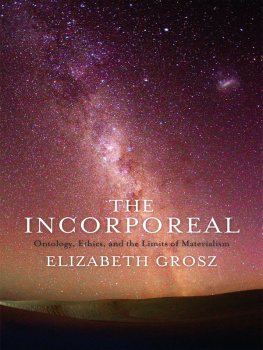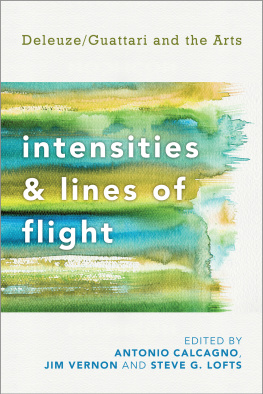Chaos, Territory, Art
Wellek Library Lectures in Critical Theory
CHAOS,
TERRITORY, ART
Deleuze and the Framing of the Earth
Elizabeth Grosz
COLUMBIA UNIVERSITY PRESS
NEW YORK
Frontispiece: Mountain Devil Lizard copyright Nancy Kunoth Petyarre.
Courtesy Walkabout Gallery, Sydney, Australia.
Columbia University Press
Publishers Since 1893
New York Chichester, West Sussex
cup.columbia.edu
Copyright 2008 Columbia University Press
All rights reserved
E-ISBN 978-0-231-51787-4
Library of Congress Cataloging-in-Publication Data
Grosz, E. A. (Elizabeth A.)
Chaos, territory, art : Deleuze and the framing of the earth / Elizabeth Grosz.
p. cm.(The Wellek library lectures)
Includes bibliographical references and index.
ISBN 978-0-231-14518-3 (cloth : alk. paper)ISBN 978-0-231-51787-4 (e-book)
1. Deleuze, Gilles, 19251995. 2. ArtsPhilosophy. I. Title.
B2430.D454G76 2008
700.1DC22
2007047572
A Columbia University Press E-book.
CUP would be pleased to hear about your reading experience with this e-book at .
References to Internet Web Sites (URLs) were accurate at the time of writing. Neither the author nor Columbia University Press is responsible for Web sites that may have expired or changed since the book was prepared.
The Wellek Library Lectures in Critical Theory are given annually at the University of California, Irvine, under the auspices of the Critical Theory Institute. The following lectures were given in May 2007.
The Critical Theory Institute
John Smith, director
CONTENTS
My strong and heartfelt thanks must go to the Critical Theory Institute at the University of California, Irvine, for inviting me to present the Wellek Library Lectures in May 2007, and particularly to John Smith, director and Lisa Ness, administrative coordinator, who made my time at Irvine remarkably smooth and stimulating. Thanks must also go to Jennifer Crewe of Columbia University Press who enabled the transition from spoken to written text to be as seamless, direct, and rapid as I could have hoped.
I owe an immense and unrepayable intellectual debt, in all my work and especially here, to Luce Irigaray who developed what I believe is the most alluring and productive concept of contemporary thought, the concept of the irreducibility of sexual difference. Without her rigorous and unflinching understanding of sexual difference as the very engine of life on earth, feminist theory would be tied to the sociological concept of gender and the horizon of egalitarianism instead of opened up to major ontological questions about matter, force, nature, and the real and to the vast explorations of a politics of difference.
Gilles Deleuze, in his own writings as well as in his collaborations with Flix Guattari, is the second major intellectual resource I have relied on here and everywhere in my work. Without his, and their, major conceptschaos, the planes of immanence and composition, territorialization, deterritorialization, and many othersI would have had nothing to say about art, at least nothing philosophical. Taken together, Irigaray and Deleuze, alone and in his collaborations with Guattari, generate a tension, their concepts do not fit together well, they produce an uneasiness that I have found exhilarating, problematic, and inspiring. Taken togetherand mediated through the writings of Darwinthey enable us to understand the productive and artistic interactions between living sexed bodies, and a dynamic, unpredictable and eventful world.
Many others, more personally accessible to me than Irigaray or Deleuze, have enabled me to prepare and complete this current project (in no particular order): Margherita Long, Jill Robbins, Joanna Regulska, Harriet Davidson, Joanne Givand, Pheng Cheah, Sue Best, Philipa Rothfield, Ellen Mortensen, Jami Weinstein, John Rajchman, and Anna Rubbo. I owe a particular debt to Claire Colebrook, who carefully read the manuscript and made incisive and helpful suggestions for change.
My various places of employmentthe Womens and Gender Studies Department at Rutgers, the School of Architecture, Design and Planning at the University of Sydney, and the Centre for Womens and Gender Studies at the University of Bergen, Norwayinstead of delaying my writing, have helped to inspire and sustain it! I am very grateful for their support and for the dynamic and provocative students I have taught in each institution who have challenged me to become as sharp and clear as I can. My thanks to all. I owe a special debt of gratitude to my familyto Eva Gross, Tom Gross, Irit Rosen, Tahli Fisher, Daniel Gross, and Mia Grosswho have always supported and encouraged me. My particular thanks to Nicole Fermon whose wit, wisdom, and inspiration lay behind this interest in the arts and my interest in their implications for reconsidering the status of philosophy.
A version of , Vibration. Animal-Music-Sex was published online for the New Constellations. Science, Art and Society Conference presented at the Museum of Contemporary Art in Sydney, March 2006.
My thanks to the Art Gallery of South Australia and Gallerie Australis for permission to publish Kathleen Petyarres Mountain Devil Lizard Dreaming (with Winter Sandstorm) on the front jacket cover and to Walkabout Gallery for Nancy Kunoth Petyarres Mountain Devil Lizard copyright Nancy Petyarre.
Art and nothing but art! It is the great means of making life possible, the great seduction of life, the great stimulant to life. Art [i]s the only superior counterpart to a will to denial of life.
FRIEDRICH NIETZSCHE,
THE WILL TO POWER
This small book is directed to questions about the ontology, that is, the material and conceptual structures, of art. While I am not trained in the visual or spatial arts, there are, nonetheless, many points of overlap, regions of co-occupation, that concern art and philosophy, and it is these shared concerns that I want to explore here. I want to discuss the origins of architecture, music, paintingindeed, the arts in generalbut not the historical, evolutionary, or material origins of art, confirmable by some kind of material evidence or empirical research such as would interest an archaeologist, anthropologist, or historian. Rather, I aim to explore the conditions of arts emergence, what makes art possible, what concepts art entails, assumes, and elaborates. These, of course, are linked to evolutionary and material forces, that is to say, to the historical elaboration of life, but are nevertheless metaphysically or ontologically separable from them.
Art, according to Gilles Deleuze, does not produce concepts, though it does address problems and provocations. It produces sensations, affects, intensities as its mode of addressing problems, which sometimes align with and link to concepts, the object of philosophical production, which are how philosophy deals with or addresses problems. Thus philosophy may have a place not so much in assessing art (as aesthetics has attempted to do) but in addressing the same provocations or incitements to creation as art facesthrough different means and with different effects and consequences. Philosophy may find itself the twin or sibling of art and its various practices, neither judge of nor spokesperson for art, but its equally wayward sibling, working alongside art without illuminating it or speaking for it, being provoked by art and sharing the same enticements for the emergence of innovation and invention. My goal is to develop a nonaesthetic philosophy for art, a philosophy appropriate to the arts that neither replaces art history and criticism nor claims to provide an assessment of the value, quality, or meaning of art, but instead addresses the common forces and powers of art, the regions of overlap between the various arts and philosophy.









